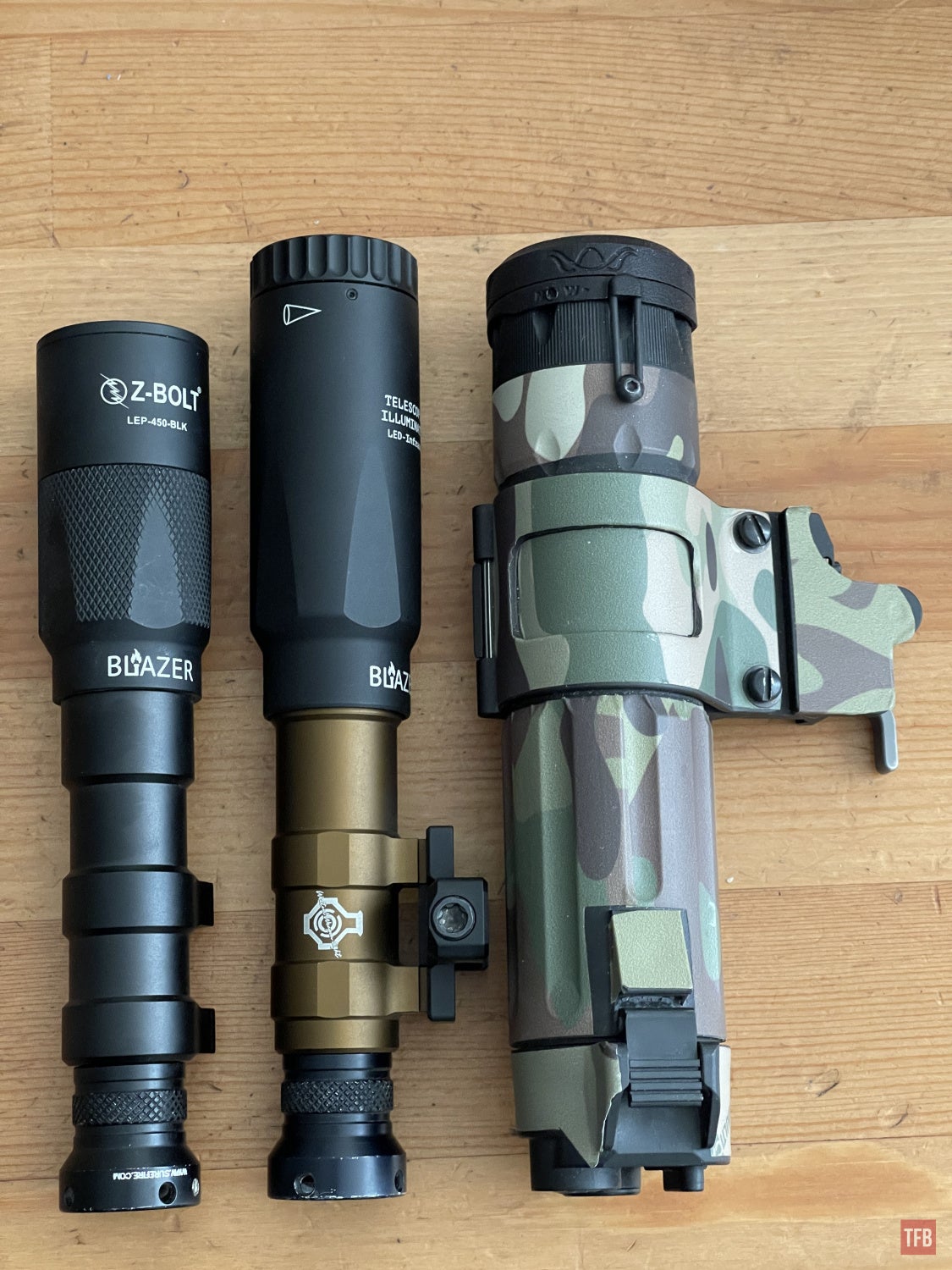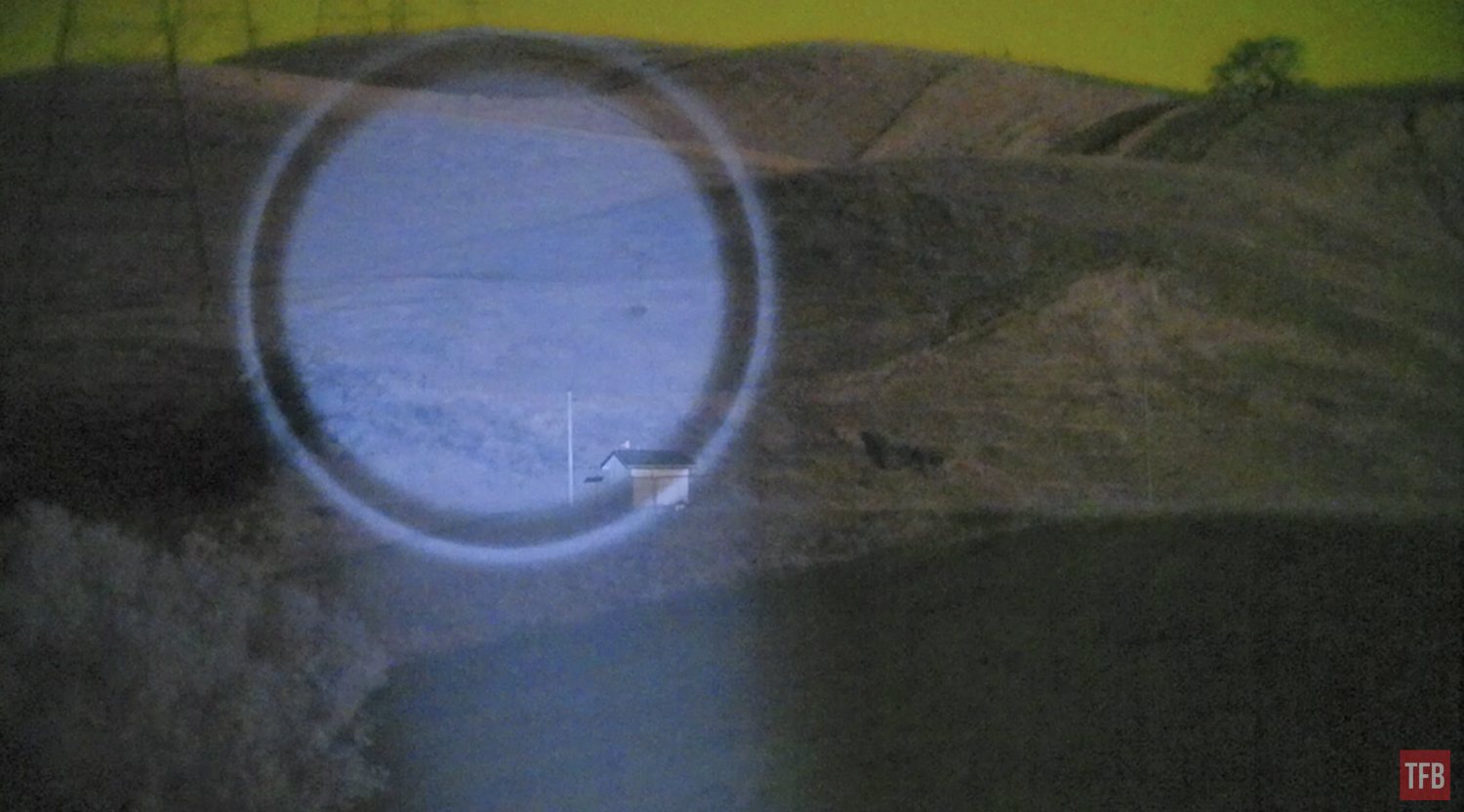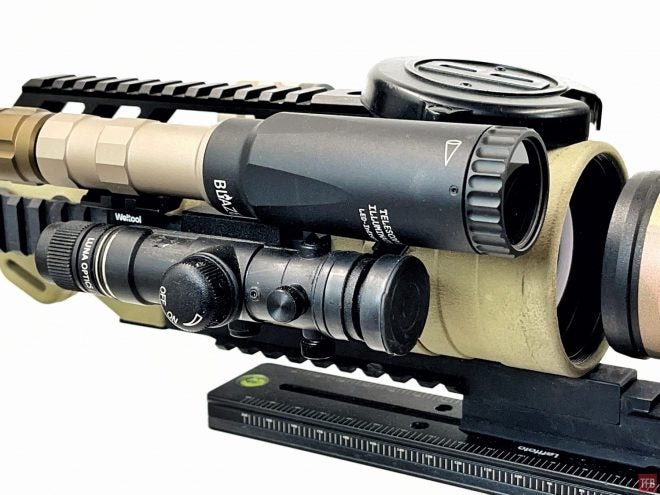Hello, fellow nocturnal enthusiasts and welcome to another Friday Night Lights. Last week we took a close look at the highly anticipated CTF2 laser/weapon light from Phantom Hill Design. Today we take a look at something new from Z-Bolt – their Blazer IR LED illuminator. Now you can add a potent long-range illuminator to your gun or spotting scope.
Illuminators @ TFB:
- Friday Night Lights: Z-Bolt Blazer LEP Weapon Light
- Friday Night Lights: B.E. Meyers KIJI K1 – VCSEL Illuminator
- Friday Night Lights: Long Range IR Illuminators – LN-ELIR-3 and SPIR
Z-Bolt Blazer IR Illuminator
With regards to infrared illumination, the typical choice is to go with an LED flashlight like a SureFire Vampire or step up to a Modlite IR head. However, these LED illuminators have their shortcomings. They often do not throw light very far or their beam patterns are too wide to be useable for anything other than illuminating an entire football pitch. Most people use an IR laser with an illuminator to shine a light far away but often you need a full-power laser which is difficult to get and their beam patterns are often misshapen or have shadow artifacts which is like looking through a dirty Petri dish. There are exceptions like the Steiner SPIR which is a glorified LED illuminator that performs just like the DBAL-D2. But the Steiner SPIR is rather large and expensive. You can get a B.E. Meyers KIJI but you will have to spend around $800 for a standalone laser illuminator.
Well, step in Z-Bolt’s Blazer IR illuminator. It is an LED-based illuminator that fits on your Modlite/DF bodies or with the use of an adapter you can mount it onto a CR123 Scout Light pattern body.

Below you will see the Z-Bolt Blazer LEP head on a Scout Light DF compatible body in the middle. Next to that is the Blazer IR LED Illuminator and finally the Steiner SPIR on its right.

L-R: Z-Bolt LEP, Z-Bolt LED IR, Steiner SPIR
The Blazer IR illuminator is rather long. On an 18650 weapon light body, it is as long as the SPIR. One cool thing about the Blazer IR illuminator is that you can power it with 3v-6v so you can use any of the following:
- Run Time: 90 Minutes – 1 pc 18350 (3.7v)
- Run Time: 240 Minutes – 1 pc 18650 (3.7v)
- Run Time: 90 Minutes – 1 pc 16650 (18650 Body) (3.7v)
- Run Time: 150 Minutes – 2 pc CR123A (18650 Body)
- Run Time: 90 Minutes – 1 pc 16650 (M600 Body & Z-BOLT® Adapter) (3.7v)
- Run Time: 90 Minutes – 1 pc CR123A (M300 Body & Z-BOLT® Adapter) (3v)
- Run Time: 150 Minutes – 2 pc CR123A (M600 Body & Z-BOLT® Adapter) (6v)
- Run Time: 450 Minutes – 1 pc 21700 (Z-BOLT® 21700 Body & Z-BOLT® Adapter – 4th QTR 2022) (3.7v)
If you want to power it with a CR123, Z-Bolt makes a Scout Light thread adapter for use on legacy Scout Light bodies.

Surefire E1 handheld with Z-Bolt thread adapter
With a CR123 length body, the Blazer IR illuminator is as long as the Blazer LEP with an 18650 body. While it looks big, the Blazer IR head is only 3.2 oz.

With the thread adapter, you have more options for mounting the Blazer IR illuminator. You can use it with the Phantom Hill CTF2 since it can run off a single 3v CR123. Although the Blazer IR head is as long as the CTF2 itself.


Since the Z-Bolt IR illuminator only needs 3v you can use a 2xAA Scout Light body or here I used an E2L AA handheld SureFire body to power the Blazer IR Illuminator head.

The lens of the Z-Bolt Blazer IR illuminator is adjustable so you can have a beam divergence of 2º to 20º.
Performance Of The Blazer IR Illuminator
The Blazer IR Illuminator throws light pretty far. It keeps up with the D2/SPIR.
I like the beam of the D2/SPIR a little more. The D2/SPIR produces a clean circular beam while the Z-Bolt Blazer IR illuminator has a noticeable 2º hotspot with a bit of spill around it for better situational awareness. Also changing beam divergence is a lot easier on the Blazer IR illuminator than the D2/SPIR.

D2/SPIR on the left, Blazer IR on the right.
Above you can see the D2/SPIR beam pattern next to the Blazer IR illuminator beam pattern. The shed is 530 yards away. With the use of a 3x focal magnifier, we can see the shed a little bit closer. See the photos below.

Close-up of D2/SPIR illuminator

Close-up of KIJI K1 3º illuminator.

Close-up of Blazer IR illuminator
Final Thoughts On The Blazer IR Illuminator
The Z-Bolt IR Illuminator performs well. It is just really big. Z-Bolt does not mention the power rating on the Blazer IR illuminator but it is eye safe. Probably the most attractive aspect of the Blazer IR illuminator is the price for performance. It is only $288 on their website. That beats out every other infrared illuminator on the market in terms of cost. You could get a Modlite IR head or a Weltool IR head for less but they will not be able to illuminate out to 1,000 yards like the Blazer IR illuminator.
Z-Bolt’s website also mentions they will be coming out with a VCSEL version of the Blazer IR illuminator. More interestingly is the wavelength options. Sure they will have an 860nM VCSEL illuminator but they will also be making them in 940nM, 1064nM and 1550nM. 940nM is for less visual signature and is better used with Photonis tubes, since they can see up to 1000nM. The 1064nM would be good to couple with a 1064nM laser like the MAWL-CLAD and other military designator lasers. The 1550nM is true SWIR range and not even full-spectrum CCD sensors can see that wavelength. You would need a SWIR imager.
I am also looking forward to their 21700 weapon light body. You will get 450 hours run time on a single 21700 and the Blazer illuminator.
For more information check out Z-Bolt’s website.
 Your Privacy Choices
Your Privacy Choices
